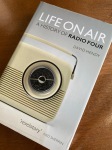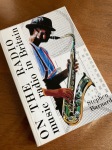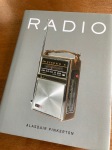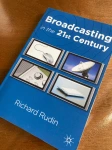This piece celebrates analogue radio on the FM band. In light of recent events it seems fitting to put down some memories and promises of VHF frequency-modulated broadcasting.

A colleague in Chile, a radio historian and researcher, asked me for any books I knew that charted the story of FM broadcasting in Britain. His request has, I think, come just at the right time. Read on for my booklist…

This decade, the 2020s, has already been marked by the dilution in the UK of both local commercial and local BBC programming. Two big groups, Global Radio (aka Capital) and Bauer Radio (Greatest Hits), have edged out local commercial names such as Pirate FM, Lincs FM and Wave 105. Likewise, BBC Local Radio is now only local between 0600 and 1400 hrs weekdays; the rest of the time it’s become regional.

A generation of radio anoraks (like me) look back fondly to the time when the FM dial presented the pops and squeaks of a myriad of local FM stations. Now a tune up the dial, especially beyond 100.0 MHz, offers a repeat of the same music and presenters/DJs on multiple transmitters. Geographic specificity seems to’ve disappeared.
Meanwhile, from my personal archives, a blast from the past from the station that in the 90s gave you “More Hits, More Headlines” in England’s biggest county… on FM:
So, let me share some web resources. FM broadcasting started in 1955 in the UK. Previously all domestic radio was on AM. In those days we called it medium wave and long wave. For foreign broadcasts short wave was the way to go. All three were “amplitude modulated”.

At the end of this paragraph is a Wikipedia article about FM in the UK. I donate a small sum to Wikipedia every time I link to their material. I find this piece is a useful starting point. Don’t please take it as the absolute gospel. That’s why articles keep getting revised.
https://en.wikipedia.org/wiki/FM_broadcasting_in_the_United_Kingdom
In Britain, in 2023, the switch-off of AM (medium wave) analogue transmitters began. In 2024 Radio 4’s long wave spot at 198 kHz, 1500 metres, also stopped having separate schedules (think The Daily Service and Test Match Special, both of which moved online and onto DAB). Some say 198’s closure all together could follow at some stage. https://www.bbc.co.uk/news/business-66644709

And a useful historical guide in pdf format can be found here: http://frequencyfinder.org.uk/History_Transmission.pdf. This is from the nice people, including Paul Groves, at http://frequencyfinder.org.uk/.
And their opinion about the future of FM in the UK? Read: http://frequencyfinder.org.uk/Opinion_FM.pdf

I promised in my previous article to include an annotated bibliography. And here it is.
In each of the books that follow, FM appears as part of the story of radio rather than the whole subject. As far as I am aware there is no one single book dedicated to the history of FM radio in Britain.
These titles therefore reflect how broadcast transmission technology was intimately bound up in the whole story and not a separate part of it.

Asa Briggs (1995), The History of Broadcasting in the United Kingdom, Volume V, Competition, Oxford: Oxford University Press. This is the final instalment of the five-volume series regarded by many media historians as the definitive work in its field. Briggs appeared happiest in his earlier volumes when all he had to consider was the BBC, with a bit of Radio Luxembourg and the occasional foreign radio broadcaster. But here he charts the advent of commercial television, offshore pirate radio and the dawn of commercial radio. His work is, of course, an institutional history of the organisations dedicated to broadcasting TV and radio. Briggs recounts how VHF/FM (he uses this term to reflect the later name change of the technology we know today simply as “FM”) was considered by various parliamentary committees and reviews from 1953 onwards, but in the event, it was BBC Local Radio in 1967 and then ILR in 1973 onwards that increased the use of the FM band.

David Hendy (2007), Life on Air: A History of Radio Four, Oxford: Oxford University Press. Asa Briggs was a full-time academic historian. David Hendy is different. David, in common with myself and some of the other writers on this list, has spent time in the industry. We’ve been broadcasters, regulators, radio producers and journalists. It is, I think, always pleasing when an academic can talk (and write) with some authority about their subject having “done it” themselves. David was a producer for BBC Radio 4’s Analysis and The World Tonight before teaching at the University of Westminster in London. One entertaining section of this book is about Scud-FM, the Radio 4 rolling news service during the first Gulf War in 1991. It’s also interesting to trace his narrative about how VHF/FM was, in the early days of R4 in 1968, seen as a potential dumping ground for Open University and Schools Broadcasting.

Tony Stoller (2010), Sounds of Your Life: The History of Independent Radio in the UK, New Barnet, Hertfordshire: John Libbey. Tony Stoller has unique experience. He was the commercial radio regulator from 1995 until Ofcom started in 2003. Tony then became an academic. His doctoral thesis, awarded by Bournemouth University, was about “Classical Music on UK Radio 1945-1995”. So, his book Sounds of Your Life is written with both an academic rigour and an insider’s nuance for the cut and thrust of regulatory meetings. It is predicated on the fact that the new wave of commercial stations had joint AM and FM broadcast licences, hence its inclusion in this reading list.

Stephen Barnard (1989), On the Radio: Music Radio in Britain, Milton Keynes, Buckinghamshire: Open University Press. Stephen is an academic and writer who has spent decades investigating the medium of radio. This book takes a sociological approach to the popular culture of British radio. From the music the stations chose to play, to the DJs, and the relationships with the music industry. He begins by quoting Queen’s “Radio Ga Ga” lyrics, and takes time to criticise some of the inane “redcoats”-style chatter of the jocks of the 1970s and early 80s. It’s a useful book that considers the programming styles of those early ILR stations.

Alasdair Pinkerton (2019), Radio: Making Waves in Sound, London: Reaktion Books. From a hobby as a DX-er he went on to do his PhD on the 1930s Empire Service of the BBC (forerunner of today’s World Service). This, his first book, appears “in association with” the Science Museum in London. As a technophile myself I enjoy Alasdair’s emphasis on the valves, transistors, loudspeakers and aerial wires of the radio transmitting-receiving ensemble. FM, for obvious reasons, looms large throughout his pages. As do short, medium and long waves. Oh, the joy of metres as opposed to kilohertz.

Guy Starkey (2011), Local Radio, Going Global, Basingstoke, Hampshire: Palgrave Macmillan. His radio experience included the Voice of Peace, an offshore radio station broadcasting from the Mediterranean to the Middle East, Radio Nova International on the French Riviera, and the British Forces Broadcasting Service in Gibraltar. Here in the UK he worked on a number of commercial radio stations and BBC Radio 4. Guy Starkey’s PhD was titled “Balance and Bias in Radio Four’s Today Programme during the 1997 general election campaign”. His book Local Radio, Going Global concentrates on the unifying aspects of local radio, and engages with the technological aspects of broadcasting on FM. What Guy did was to make connections between local radio across several continents. His conclusion was that what was special about Britain also applied to North America, British Commonwealth countries, and much of Europe too.

Richard Rudin (2011), Broadcasting in the 21st Century, Basingstoke, Hampshire: Palgrave Macmillan. He has experience as a newspaper journalist as well as working for Beacon Radio in Wolverhampton and BFBS in Germany. He teaches journalism at Liverpool John Moores University. His book discusses both radio and television as well as online. He includes Al Jazeera, reality celebrity Jade Goody, the campaign to save BBC Radio 6 Music, Kenny Everett, MTV and citizen journalism. It’s an eclectic mix. But a strong theme is how radio, as a medium, has continued to survive: changing with each technological advance. FM, naturally, has been one of the mainstays since the advent of pop radio in the late 60s.

Brian Regal (2005), Radio: The Life Story of a Technology, Westport, CT: Greenwood Press. Brian is based in the USA and is an academic historian with special interests in science and technology. His book Radio: The Life Story is a delight for technology lovers like me: it’s dripping with details of AM, FM, transistors, and radio personalities. It’s focussed on a US tech history of the medium, but given that so much of Uncle Sam’s playfulness with radio took more than a few decades to make it over the Atlantic to be Anglicised for a very British audience it’s a delightful story to follow.

Indeed when it comes to radio station formats, it was the USA that gave the world the notion that the FM band should be used for the broadcast of quality music (classical, contemporary album tracks, and so on). The acronym FM became known for broadcasting adult orientated rock formats. Pop music was consigned to AM. And so it was in Britain, where ILR stations ran their “gold” services of oldies on their medium wave frequencies.
Which brings me to the movie FM (1978), directed by John A. Alonzo and released in the USA by Universal Pictures.
It spawned the eponymous theme song by Steely Dan. That tune, musically smooth and luxurious as it was, had lyrics that were somewhat at odds with the film’s narrative. The band (Walter Becker and Donald Fagen) suggested a real world where FM stations were transforming themselves into money-making endeavours by playing “nothing but blues and Elvis” in an effort to capture listeners to sell to advertisers.

The movie’s plot, however, was more utopian: about the DJs and presenters saving their own specialist rock station by keeping the music the main thing, not the profits.
In Britain the letters FM were used as the title of a short-lived sitcom, broadcast on ITV 2 (at the time, reckoned to be a “youth” station), between 25th February and 1st April 2009. It only had half a dozen episodes and starred Chris O’Dowd (also in The Boat that Rocked), Kevin Bishop and Nina Sosanya. Be warned: some of the dialogue is of an adult nature.
Meanwhile, an episode in 1985 of the BBC radio comedy Radio Active opened with a satirical reference to poor-quality reception:
And now a choice of listening. On VHF we have another in our series of cultural exchanges with BBC Radio 4. Listeners on medium wave can hear the same thing but with an altogether more muffled sound and a lot of sibilant esses. While listeners on short wave can hear a great deal of interference with bits of Morse code and the occasional police message. Here on long wave, there’s an unexpected Dutch station cutting in.
That is from the “Wimbledon Special” (5 July 1985) edition of Radio Active, on BBC Radio 4. Series 5, Episode 1.

Find more about movies, TV and radio shows like these in my book Radio’s Legacy in Popular Culture.
**Footnote** The title of this piece is an intentional mis-quote from the call-and-response pre-punk classic “Roadrunner” by Jonathan Richman and the Modern Lovers. I’ve written about it here, where you can also find a link to the video/audio of this classic radio-related song.
Let me know your FM stories. Drop me a comment in the box below.
getting my first little transistor radio for Christmas in about 1985, and listening compulsively in my room to Clyde 1 – that’s an early memory!
Great piece
LikeLike